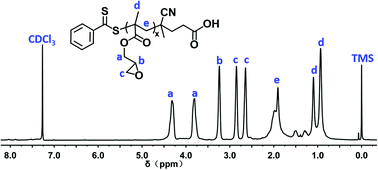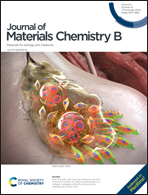Fabrication of aminated poly(glycidyl methacrylate)-based polymers for co-delivery of anticancer drugs and the p53 gene†
Abstract
Aminated poly(glycidyl methacrylate)s-based polymers for gene delivery not only can reduce toxicity and improve solubility, but can improve gene transfection efficiency and reduce protein aggregation. In this study, we first prepared poly(glycidyl methacrylate) (PGMA) via reversible addition–fragmentation chain transfer (RAFT) polymerization, and then the obtained PGMA homopolymer was post-modified with ethanol amine (EA), 1-amino-2-propanol (AP), 3-(dibutylamino)propylamine (DA) and N-(2-hydroxyethyl)ethylenediamine (HA), respectively, to yield four kinds of PGMA-based gene vectors containing hydroxyl groups (abbreviated as PGEA, PGAP, PGDA and PGHA). The effects of the different side chains and hydroxyl groups on the biological properties of these four cationic polymers were investigated. We found that the transfection efficiency of the PGHA/p53 complex was higher than those of the other three polymer/gene complexes through MTT assay and laser scanning confocal microscopy. Hence, we chose HA for further post-modification to fabricate a cationic copolymer, PCL-ss-P(PEGMA-co-GHA) (abbreviated as PGHAP), via a combination of ring opening polymerization (ROP) and RAFT copolymerization. The PCL-ss-P(PEGMA-co-GHA) amphiphilic copolymer could self-assemble into nanoparticles, which could be used to encapsulate anticancer drug doxorubicin (DOX) and compress the p53 gene to form the DOX-loaded PCL-ss-P(PEGMA-co-GHA)/p53 complex (abbreviated as DPGHAP/p53). The gel retardation assay showed that p53 gene could be well immobilized and remained stable under the electronegative conditions. MTT assay showed that the DPGHAP/p53 complex had a significant antitumor effect on A549 cells and H1299 cells compared with free DOX or/and p53 gene therapy alone. Furthermore, the test results from live cell imaging systems revealed that the DPGHAP/p53 complexes could effectively deliver DOX and the p53 gene into A549 cells. Therefore, the constructed cationic polymer PCL-ss-P(PEGMA-co-GHA) has potential application prospects as a co-vector of anticancer drugs and genes.



 Please wait while we load your content...
Please wait while we load your content...